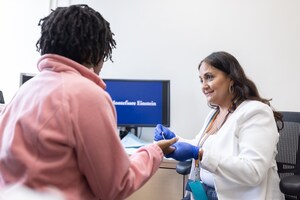How To Enjoy Summer Days While Preserving Your Skin
Montefiore Dermatologist Debunks Common Misconceptions About Skin Protection
BRONX, N.Y., June 17, 2015 /PRNewswire-USNewswire/ -- As many begin to spend long summer days outside, it's crucial to have the right information about skin protection and the dangers of sun exposure. Today, Montefiore dermatologist Dr. Holly Kanavy debunks many widely-shared myths regarding skin care and offers accurate information to help people enjoy the outdoors this summer while preserving their skin.
"There are many dangerous misconceptions when it comes to how people acquire sun damage," said Dr. Kanavy, assistant professor of Medicine and director of Pharmacology at Montefiore Health System and Albert Einstein College of Medicine. "Ultraviolet radiation is a known carcinogen, which means similar to cigarette smoking, it can cause lasting damage to the body. In a healthy cycle the body disposes of cells containing too much DNA damage. When we expose ourselves to excessive amounts of UV radiation, the body cannot get rid of all of the damaged cells and they live on. That's why when we protect ourselves from the sun, we are protecting the core of our being – our DNA."
According to Dr. Kanavy, here are the top five skin protection myths:
Myth 1: You only need to protect yourself during peak sunlight hours. While you should be extra careful between the hours of 10 a.m. and 4 p.m., any time your shadow is short, UVB rays, the rays responsible for skin redness and sunburn are a present danger. If you are outdoors during peak hours, wear clothing with built in SPF. Certain people may be good candidates for sun protective pills that use fern extract to increase the amount of time it takes for the skin to burn.
Myth 2: If the kids aren't burned they are wearing adequate sunscreen. Young skin can be particularly vulnerable to damage. Children should wear and reapply at least one ounce of broad spectrum SPF 30 or higher sunblock. Hats and sunglasses can also help protect them. While clothing, especially darker colors, offers some protection, wet clothes don't protect much at all.
Myth 3: I need sun exposure to get vitamin D. The amount of vitamin D needed for optimum health benefits can usually be acquired during 10-15 minute intervals of sun exposure a few times per week. People who have low vitamin D levels can supplement their intake with vitamins and fortified foods. Sunscreen takes 20 minutes to start working after application, so vitamin D can be acquired in the time it takes your sunscreen to kick-in.
Myth 4: The most important thing to read on a sunscreen label is the SPF factor. Sunscreens are most effective when they are broad spectrum. That means they are UVA and UVB protectant. UVA rays are present during all daylight hours and penetrate the skin deeper than UVB rays. They play a major role in skin aging and the development of skin cancers. The only way to be sure sunscreen protects from UVA and UVB is to read the label. Look for the words "broad spectrum" and ingredients such as avobenzone, oxybenzone, zinc oxide, and/or titanium oxide.
Myth 5: I do not need sun protection indoors or on cool days. The temperature is not a measure of radiation. UVA rays can penetrate cloud cover and even glass. About 50 percent of radiation can pass through a home window and 60 percent through a car window. UVA will not cause tanning, but can cause damage. Dr. Kanavy recommends making sunscreen a part of your daily routine – even if you plan to spend the day indoors.
If you happen to forget your sunscreen, there are still steps you can take to protect your skin.
"Immediately after a burn, take a cool shower and keep the burn moisturized," says Dr. Kanavy. "Ingredients like vitamin C and vitamin E can help control damage. Weeks later, retinoids and alpha hydroxy acids are great because they increase cell turn over. The longer a damaged cell sits the more chances it has to spread its damage. People should remember there is still fun to be had in the shade."
For more information about sun protection, please visit www.Montefiore.org.
About Montefiore Health System
Montefiore is a premier academic health system and the University Hospital for Albert Einstein College of Medicine. Combining nationally-recognized clinical excellence with a population health perspective that focuses on the comprehensive needs of the communities it serves, Montefiore delivers coordinated, compassionate, science-driven care where, when and how patients need it most. Montefiore consists of eight hospitals and an extended care facility with a total of 2,747 beds, a School of Nursing, and state-of-the-art primary and specialty care provided through a network of more than 150 locations across the region, including the largest school health program in the nation and a home health program. The Children's Hospital at Montefiore is consistently named in U.S. News' "America's Best Children's Hospitals." Montefiore's partnership with Einstein advances clinical and translational research to accelerate the pace at which new discoveries become the treatments and therapies that benefit patients. The health system derives its inspiration for excellence from its patients and community, and continues to be on the frontlines of developing innovative approaches to care. For more information please visit http://www.montefiore.org. Follow us on Twitter; like us on Facebook; view us on YouTube.
SOURCE Montefiore Health System
Related Links
WANT YOUR COMPANY'S NEWS FEATURED ON PRNEWSWIRE.COM?
Newsrooms &
Influencers
Digital Media
Outlets
Journalists
Opted In




Share this article